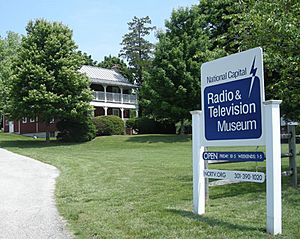- This page was last modified on 9 August 2025, at 10:56. Suggest an edit.
National Capitol Radio & Television Museum facts for kids
| Lua error in Module:Location_map at line 420: attempt to index field 'wikibase' (a nil value). | |
| Established | June 1999 |
|---|---|
| Location | 2608 Mitchellville Rd Bowie, Maryland |
Ever wonder what life was like before smartphones and the internet? The National Capital Radio & Television Museum in Bowie, Maryland, shows you just that! It's a cool place where you can explore the history of radio and TV. You can see how technology changed from the very first signals sent through the air to the classic shows your grandparents might have watched.
What's Inside the Museum?
The museum is filled with amazing old radios and televisions. It tells the story of how these amazing inventions developed over time. You can learn how electronic media has changed our world.
There are fun, hands-on displays that show you how radio waves work. You can also listen to old radio shows and watch clips from early TV programs. It's a great place for anyone curious about technology.
The museum is open to visitors on Fridays from 9 AM to 4 PM, and on Saturdays and Sundays from 12 PM to 4 PM. There is a fee for admission.
A Journey Through Time in the Galleries
The museum has seven galleries that take you on a trip through the history of broadcasting.
- Gallery 1: Wireless Beginnings
This gallery shows how it all started with "wireless telegraphy." This was a way to send Morse Code messages through the air without any wires!
- Gallery 2: The Birth of Broadcasting
Here, you'll see how the first radio broadcasts began. People would often build their own simple crystal radios at home to listen in.
- Gallery 3: Radio Comes of Age
In this section, you'll learn about a time when radios became a common sight in American homes. The government even created the Federal Communications Commission (FCC) to help organize all the new radio stations.
- Gallery 4: Radio’s Golden Age
As technology got better, radios became smaller and cheaper. For many families, listening to the radio together was the main source of entertainment, just like watching TV or streaming shows is today.
- Gallery 5: Post-War Radio
Radio was still very popular after World War II, but a new invention was about to change everything: television!
- Gallery 6: The Rise of Television
This gallery explores 20 years of television design. You can see how TVs changed and how different ideas for showing pictures were tested.
- Gallery 7: How It All Works
Have you ever wondered how they made the sounds for old radio dramas? This gallery brings the cool sound effects of early radio back to life.
How the Museum Began
The story of the museum starts with a group of friends. In 1984, some people in the Washington and Baltimore area who loved collecting old radios formed a club. It was called the Mid-Atlantic Antique Radio Club (MAARC).
Soon, the club members wanted to share their amazing collections with everyone. They dreamed of opening a museum. To make this happen, they created a new organization in 1993 just for building a museum about radio and television.
At first, they had no building, no money, and only a few volunteers. They borrowed old radios from collectors and set up small exhibits in libraries and other public places. They kept looking for a permanent home for their museum.
In 1998, they found the perfect spot: an old farmhouse in Bowie, Maryland. The city of Bowie owned the building and had already restored it. The museum's leaders made a presentation to the city, and in 1999, they signed a lease. The Radio & Television Museum officially opened in June 1999.
Today, the museum is known as the National Capital Radio & Television Museum. It works in partnership with the City of Bowie, which takes care of the building, while the museum staff runs the exhibits and programs.

